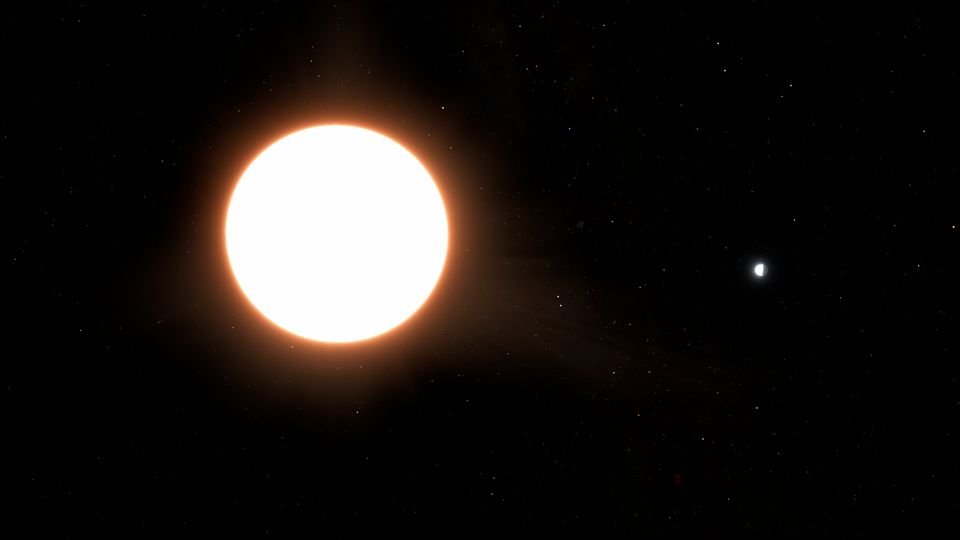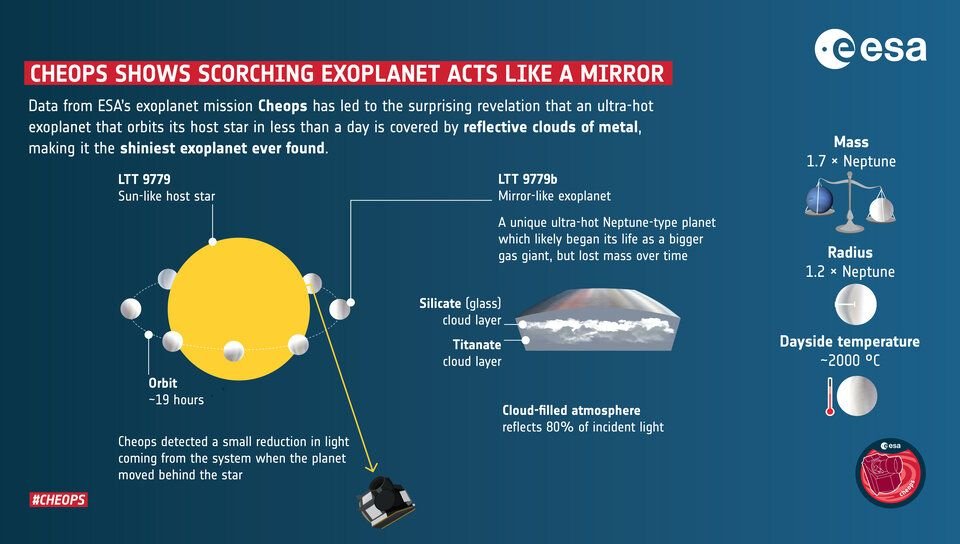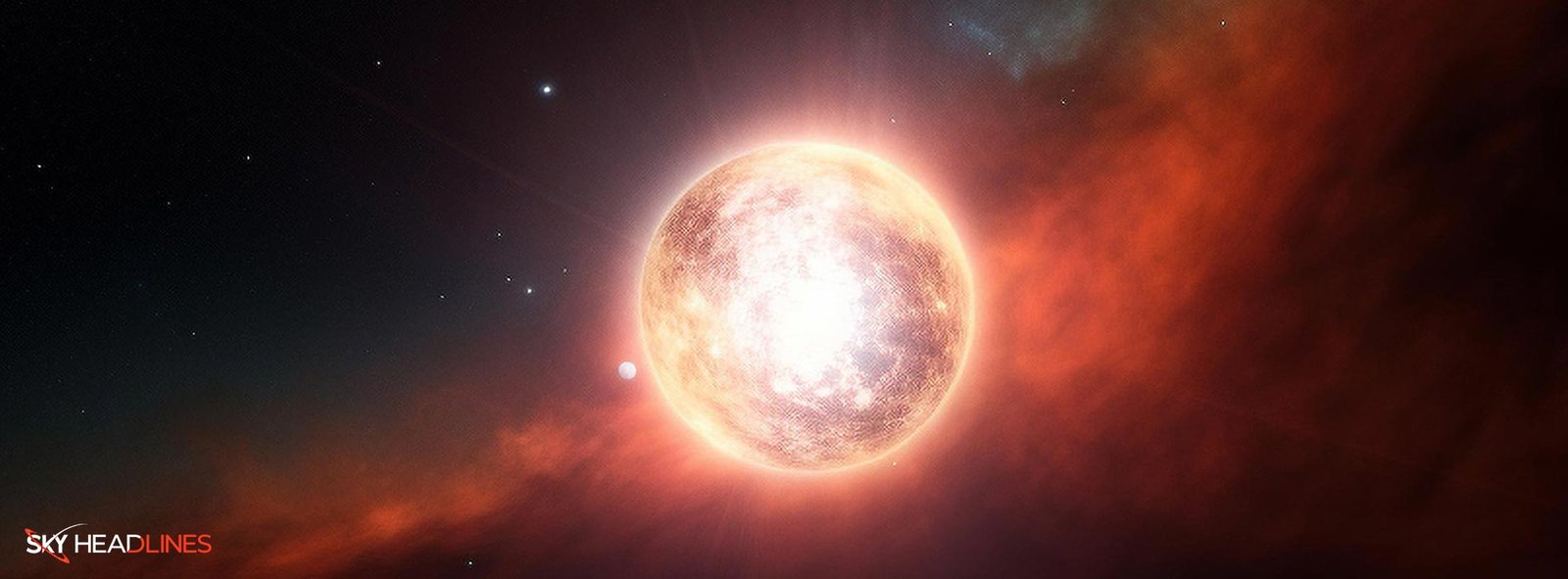Now, for the first time, scientists have found an exoplanet by Cheops that shines as brightly as Venus. Aside from the Moon, Venus is the biggest thing we can see in the night sky. Its thick layer of clouds returns about 75% of the Sun’s light. On the other hand, Earth only produces about 30% of the light that comes its way.
This planet, LTT9779 b, is the first of its kind. New readings from the ESA’s Cheops mission show that this planet returns 80% of the light from its host star.

What was the Cheops mission’s role in follow-up observations?
The high-precision readings made by Cheops were meant to follow up on what NASA’s TESS mission and ground-based instruments like the ESO HARPS instrument in Chile found and learned about the planet in 2020.
The world is about the same size as Neptune, which makes it the most enormous “mirror” or Cheops we know of in the Universe. Its high reflection comes from the silvery clouds that cover it. Most of them are made of silicate, the same material as sand and glass, mixed with metals like titanium.
James Jenkins, a scientist at Diego Portales University and CATA in Santiago, Chile, says,
“Picture a world that is on fire and close to its star. Heavy clouds of metals are floating in the air, and titanium rain is falling from them.”

The amazingly high elevations of Albedo on LTT9779 b
Today, the journal Astronomy & Astrophysics released a scientific study James co-wrote. It talks about the new research. Metal clouds fill the sky. A thing’s “albedo” is the amount of light that it reflects. Most planets have a low albedo because their atmospheres absorb much light or their surfaces are dark or rough. Ice worlds and planets like Venus, which have clouds reflecting light, usually differ from this.
The high albedo of LTT9779 b was a surprise because the side of the planet that faces its star is thought to be around 2000 °C. If the temperature is over 100 °C, water clouds can’t form, but the temperature of this planet’s atmosphere should be so high that even metal or glass clouds can’t start.
What were some perspectives regarding Cheops’ mission?
Vivien Parmentier, a researcher at the Observatory of Côte d’Azur in France and co-author of this study says about Cheops mission;
“It was a real puzzle until we realized that this cloud formation was like condensation in a bathroom after a hot shower,”
“To make a bathroom steamy, you can either cool the air until the water vapor condenses or keep the hot water running until clouds form because the air can’t hold any more vapor.”
A quick introduction to LTT9779 b, a hot Neptune
Even though LTT9779 b is very hot, metallic clouds can form because the atmosphere has too much silicate and metal vapor.
LTT9779 b is more interesting than the fact that it is shiny. It is called an “ultra-hot Neptune” because of its size and temperature, but no other planet of this size and mass has been found to circle so close to its star. It lives in the “hot Neptune desert” because of this.
The planet’s radius is 4.7 times that of Earth, and a year on LTT9779 b lasts only 19 hours. All the worlds found so far that circle their star in less than a day are either “hot Jupiters,” gas giants with a radius at least ten times bigger than Earth’s, or rocky planets smaller than two Earth’s radii.
“It’s a planet that shouldn’t exist,” Vivien says. “We think that planets like this will have their atmosphere blown away by their star, leaving only rock.”
First author Sergio Hoyer of the Marseille Astrophysics Laboratory says,
“We think these metal clouds help the planet survive in the hot Neptune desert.”
Because the clouds reflect light, the world doesn’t get too hot and starts to boil off. Also, the world and its atmosphere are heavy and hard to blow away because they have a lot of metal. They were studying an alien planet by looking for it via Cheops when it was not visible.
What was the role of Cheops in analyzing LTT9779 b?
Cheops, an ESA project to study exoplanets, looked at LTT9779 b when it moved behind its mother star to find out what it was like. Because the planet reflects light, the principal and world send more light to the space telescope right before the earth goes out of view than right after. You can tell how much light a world returns by comparing how much visible light you get before and after the earth is covered.
This project depended on the accuracy of Cheops and the ability to be on call 24/7.
Sergio says,
“Only Cheops could measure the tiny change in the signal caused by the star passing in front of the planet.”
Maximilian Günther, who works on the Cheops project for ESA, says,
“Cheops is the first space journey ever designed to follow up on and learn more about known exoplanets.”
Cheops has more freedom than big projects that look for new exoplanet systems. It can quickly focus on attractive targets and reach a level of coverage and accuracy that we often can’t get any other way.
We get the whole picture when we use different tools to look at the same world. Emily Rickman, a science operations scientist at ESA says;
“LTT9779 b is a great place to keep an eye on because both the Hubble and James Webb space telescopes are so good,”
“They will let us study this exoplanet with a wider range of wavelengths, such as infrared and UV light, to learn more about how its atmosphere is made.”
What is the future mission of Cheops and other Exoplanets?
Cheops is the first of three specialized efforts to study exoplanets, so there is much to look forward to in the field. It will be joined in 2026 by the Plato mission, which will look for planets like Earth far enough from their star that life might be possible. Ariel will join the fleet in 2029, and her primary job will be to study the atmospheres of other planets.





